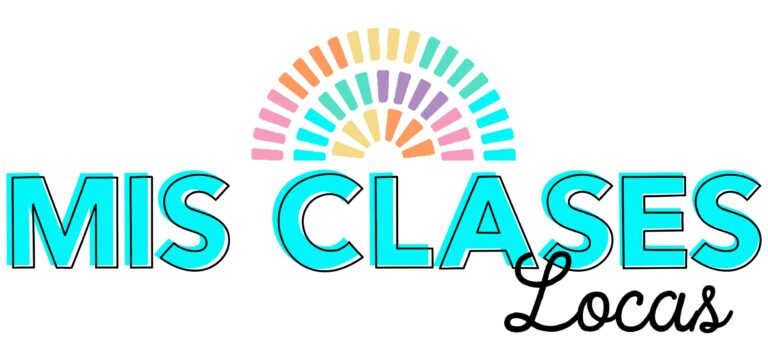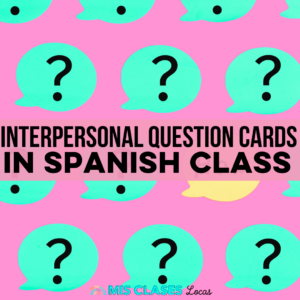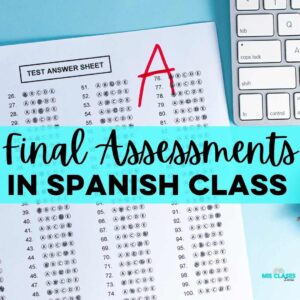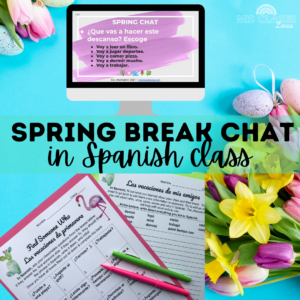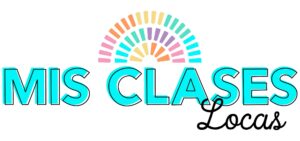Inside: Assess Spanish speaking. How to assess and efficiently grade World Language Interpersonal assessments or Spanish finals. Interpersonal speaking assessments in Spanish class.
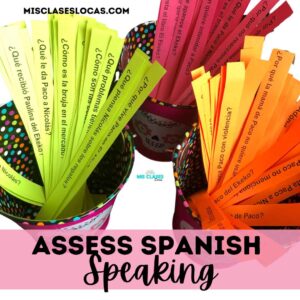
Over the years I have posted about many Speaking Activities for Spanish Class. If you are looking for games for test review and speaking practice in Spanish class check these blog posts out.
- Find Someone Who Interpersonal Speaking
- Weekend Chat 10 Ways to Mix Up Weekend Talk
- Spanish Question Cards for Interpersonal
- Persona Especial
- Talk About Music in Spanish Class
- Café y Conversación
This post will focus on Spanish speaking exam tips for teachers. This includes how to assess and efficiently grade World Language interpersonal assessments or Spanish finals.
Interpersonal Speaking Assessments Spanish Class
Notice I never mention presentational speaking, but rather all interpersonal speaking. This is intentional. Interpersonal speaking is far more useful in the real world. In authentic speaking, there is a negotiation of meaning.
Unless a student is going to become a Spanish TV newscaster, food show host, or give business proposals in Spanish, interpersonal speaking is much more useful.
Additionally, this post focuses on efficiently assessing and grading speaking assessments. It is far more efficient to asses speaking in pairs or small groups. This saves you half the time and gives you a much more authentic interaction in Spanish to assess.
This post goes from most supported to Assess Novice Spanish to Upper-Level Spanish Speaking Finals.
Assess In Pairs at Teacher Desk – With Question Cards
Novice students are given a specific topic. They should have practiced these questions a lot, and none should be a new surprise. The goal is to show what you know.
For example, at the end of my Super 7 Unit to Start Spanish 1 the speaking assessment is to ask and answer the same special person questions in pairs. Students use differentiated versions of these Super 7 conversation cards.
I have made it a goal to better support novice students’ speaking assessments. The biggest change came from an idea from my instructional coach. She asked how I would differentiate the Spanish final speaking assessment from the novel for students with IEPs.
Our solution to support all Spanish 1 students in speaking assessments was question cards. I typed up general, open-ended questions about the book. I printed them in two separate colors for two different levels of questions. These questions depended on whether their goal was to be proficient or to show thorough understanding.
When I wrote how to assess a novel in 2016, I did not do a great job including Differentiation. I didn’t yet mention assessments in Spanish interpersonal speaking using question cards. Once you know better, you do better.
>> Want more info about teaching a novel, check out How to Teach Comprehensible Spanish Books

Want more support assessing novice Spanish speaking?
In addition to printed conversation cards, have students practice with these conversation cards in many ways during the unit.
I make multiple sets of the same Spanish conversation cards. Laminate the cards and they are the perfect fast-finisher activity or class starter. Yes, there are some practiced memorized responses, but that is what novice baby parrots do.
See below for how I use these conversation cards in an assessment. There is the addition that the pair of students draw about five random questions to ask each other in Spanish.
Assess Speaking In Pairs – Student-Created Questions
Day of Spanish Assessments
Give students the speaking prompt the week before. It can be general such as asking and answering questions about the novel and unit. If students are creating their questions I let them prepare a notecard to use.
Randomly draw two students to the teacher’s desk at a time. It has to be random, because if two people who practiced together are assessed that is presentational, not interpersonal since there is no negotiation of meaning. Students come with a notecard, sit in a comfy chair, and talk in Spanish for the allotted time. I have expectations with helpful phrases right there as well.

How to grade assessments in Spanish speaking?
*Efficiency Pro tip* Write the students’ names on the mini-speaking rubrics in advance. Draw out 2 names to speak & 2 names to be ready & on deck. This helps to keep things moving.
Be clear on the goal of the Spanish proficiency level. Grade using a performance-based rubric.
For example, when I used full Standard Based Grading with a 4-1 scale, a late Spanish 1 assessment was 4-Novice High, 3-Novice Mid, and 2-Novice Low, below that try again.
Students are usually terrified for their first speaking assessment because it is so different from traditional tests. Many realize they would rather have this open-ended assessment and consider it easy, “You just listen and talk in Spanish!”
What does the rest of the class do during pairs speaking assessments?
The expectation is they are quietly working so the teacher can hear the assessments. While an assessment is in progress students should not interrupt unless there is a legitimate emergency. Questions must be asked during the transition between speaking pairs.
The rest of the class has a list of tasks projected on the board that they should be working on quietly. This list includes preparing to speak, preparing for the writing assessment later in the week, free reading in Spanish silently, completing missing work, Duolingo, and Sr. Wooly. etc.
If you are efficient and limit speaking to 2-3 minutes, with quick transitions you can get these Spanish speaking assessments done in 1-2 days. If you have larger classes, or students are uncomfortable with others listening in the room, they can record the conversation with a random pair. Another option is volunteers can speak in a small group setting with the teacher during homeroom/MTSS time.
Simultaneous Small Groups Spanish Speaking Assessments
*Upper-Level Spanish Speaking Assessment option
In Advance to prepare for the Spanish Final Speaking
Teach students how to write good, open-ended questions. Spend a class period working on creating questions over a specific topic or novel in Spanish. if you skip this step, there is a guarantee that many students will not be prepared with questions to speak. This causes stress on the whole group.
“Question Writing Competition” – teach students to write questions
I created this question writing competition on the fly in Spanish 3 to prepare for a speaking assessment over Robo en la noche. Students were split into group with a big piece of bulletin board paper. They had 10 minutes to write as many questions over the topic as possible. They were encouraged to use all the posted question words & use a variety of types of questions.
Then groups rotate papers. They used different colored markers to annotate the large sheet of questions. Star open-ended questions, heart the best question, and fix any errors. If students care about an actual competition you can give awards to the best questions, group etc.
Rotate a couple of times, so students can read a variety of questions. The real reward is students get a chance to see a ton of questions they can use the next day in the speaking assessment.
Then individually students write a list of personal questions. They can use this notecard the next day during the speaking assessments in Spanish.

The Day of the Simultaneous Speaking Assessments
Have students’ names written on these mini Speaking Rubrics. Use these cards and split them into random small groups of about four students. Separate these groups around the room. They bring their pre-written questions to the group.
*Efficiency Pro tip* You could have up to about 4 groups of 4 speak at the same time. This is grading 16 students at the same time. But, this depends on your class size, capacity for simultaneous grading & long your groups can sustain a conversation. Maybe start with 2-3 groups at once to see how it goes.
*NEW & I would highly recommend* – Conversation Cards
I gave each group a laminated set of bail-out questions. Depending on your topic here are a few sets of question cards I have used.
- Spanish Novel Conversation Cards
- Conversation Cards for Preterite Ir – Fuiste
- Spanish Conversation Cards Mi Verano 1st Unit of School
- Spanish Conversation Cards Bundle
These conversation cards support those team members who show up not prepared, as well as to keep the conversation going. This ensured that other group members were not punished for being put in a group with a not prepared student. It also gave them more to talk about, which meant longer for me to walk around and hear everyone talk.

Grading these assessments in Spanish simultaneously
*Efficiency Pro tip* Have a clipboard with each group’s mini rubrics. Listen & grade as students speak.
Walk around and assess everyone on the spot. If you have large classes or need more time to grade, you could have the small groups record their conversations and listen to them later.*
If you need to hear students speak more, after about 10 minutes shuffle students into new groups. Students might say some of the same things, but they are more confident in round two.
If needed, you can also rearrange them into groups you have already graded and those you still need to hear. They do not know this. Hang out in the middle of a few groups, specifically listening to certain students’ answers.
Simultaneous Spanish Speaking Exam Tips
After multiple speaking assessments at my desk, the first time I tried this style of speaking assessment was in semester 2 of Spanish 2. It works well in Spanish 3 & 4, especially during the Lit Circle unit. I would not try this as an assessment with Spanish 1. They do not have the vocabulary to sustain a conversation long enough to float around and hear all groups.
On these days I needed to be on my A-game and ready to listen to many students at once. But, I do like that by the end of class, I have them pretty much graded. Besides recording, you could even do this kind of assessment more frequently but only assess half the class at a time.

Other Interpersonal Assessments
Have students record & listen later (Flipgrid)
With larger classes, I know that recording and listening later is often the last resort. Just do not burden yourself with too much out-of-class grading! Even if you can get half done in class in person, it saves you a ton of time.
Fishbowl Interpersonal Speaking
This type of speaking has 1/3 of the class in the center speaking and the other 2/3rd on the outside listening. Students rotate in to be able to speak. Try it as an activity before you use it as an assessment.
If it is an assessment, be very clear with expectations. Make sure everyone gets a chance to speak in the center.
Fishbowl speaking works well to have groups of 3 each labeled person A, B, & C. When all As are the in center, their B & C group members are specifically listening & giving feedback to their group members. Then when the Bs are in the center the A & C group members are listening, etc.
Learn more here >> Fishbowl Speaking in Spanish class
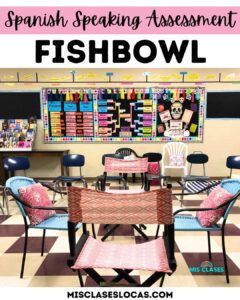
Need more help with Spanish Final Exams?
- Practice Writing in Spanish Class
- Final Assessments for Spanish class
- How to Assess a Novel in Spanish class
- Games for Test Review > Fun Spanish Classroom Games
>> To support your Spanish students’ Spanish speaking assessments, grab my conversation card bundle.
Want my favorite Novice Speaking Activity?
Grab my name game speedball slides below.
